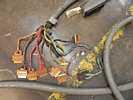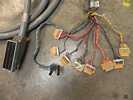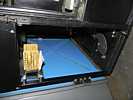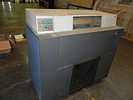







|
Links to 1403 pictures and text in the 1401 Restoration Log
Comments from Carl Claunch to Binghamton, April 29, 2013,
|
This is excellent – I was worried that the Binghamton group would have only connectors on the 1403, no cables, but this printer has both cables and has the SMS style paddle cards on the ends.
The 360/20 machine logic diagrams show the entire SMS (14xx technology) adapter that is integrated into a 360/20, thus the majority of the circuitry that would fit in a 1446. Susan has some choices to make but the good news is that if the will and budget are there, it is 100% certain (to me) that they can have a 1403 sitting in the museum printing away. That is, there is enough information and the printer appears in good enough condition to get to that goal. Minimalist case: enough of the 1440 era (SMS) adapter logic is recreated, along with power supplies and an enclosure, to spit out some canned text on demand (by pushing a button). That text could easily be stored on an SD card or similar modern storage unit to allow the canned text to be changed on a PC, perhaps to customize the text to holidays, names of visiting groups or other desirable customization. This would be done most easily by converting the logic voltages and protocols from SMS to modern levels where the 1403 hooks up via paddle cards. All the adapter logic is ‘logically’ identical to the 360/20 integrated adapter (1446 and 2821 adapter equivalent), but uses microprocessors and other simple, inexpensive and easily mastered tools. More complete case, but still unconnected to 1440: complete the adapter logic plus an interface such as USB to allow this to be hooked to and driven by a modern computer, giving a much larger repertoire of text and behavior, the chance to make dynamic changes to what is printed, and an opportunity to allow a bit of educational activity – “design output to fit a preprinted form and print the data in the intended places” – perhaps as part of a summer program that includes museum activities. Both of the above cases require no additional research or information. All that would be needed is to design and build the interface using logic diagrams and other information that is unambiguous, complete and at hand. Lesser of the two 1440 driven printing cases: figure out a means of driving the newly recreated adapter logic from the 1440, based on what circuitry is already configured in the machine and a modest amount of additional interface circuitry. In this case, another thin layer of voltage/protocol converting hardware is placed between the modern technology that recreates all the logical functioning and the paddle card ends or similar means that would be fitted into the 1440 system. May not be straightforward to program for, probably does not look like any real 1440 peripheral to the programmer, but custom programs could be written for the 1440 that caused printing to occur from this approach. Any surviving 1440 programs brought into the museum would not print to this printer unless they were modified. This case requires quite a bit more research, unless we are lucky and find 1446 diagrams, or the 1440 logic diagrams for a machine that had a 1403 attached. A very detailed inventory would need to be made of the cards installed and logic that exists in the museum’s 1440 system, then design choices would have to be made for the most feasible way to hook the new circuitry into the 1440. This may even require a detailed recording of the backplane wiring at candidate slots where paddle boards from the newly recreated printer interface might be inserted into the 1440. Greater of the two cases for the 1440 driving the printer: Figure out a way to implement this such that it appears programmatically identical to a 1403 that would have been configured on the system back in the day. Requires research to understand what is needed in the 1440 and at the connection to the newly recreated ‘1446’ controller, then recreation of that circuitry. It may require recreation of portions of a 1440 that are not installed in the machine in Binghamton, but that would have been in a machine that has a 1403 installed. Some part of this might be accomplished leveraging spare SMS cards but there are very serious challenges in the backplane wiring and overall logic of the 1440 to make this happen, very very difficult unless full documentation can be recreated of the complete 1440 circuitry and wiring, the complete 1446 and all the detailed wiring necessary. This has the benefit of permitting the 1403 to be used with legacy programs from the past that were written to print on a 1440-attached 1403 printer, but it is by far the most substantial of the cases. I think it would be good at this point for Susan and her restoration team to make some decisions about objectives and which case they wish to pursue. The expense and time, as well as complexity, go up with each step up from the first case to the fourth. Carl |